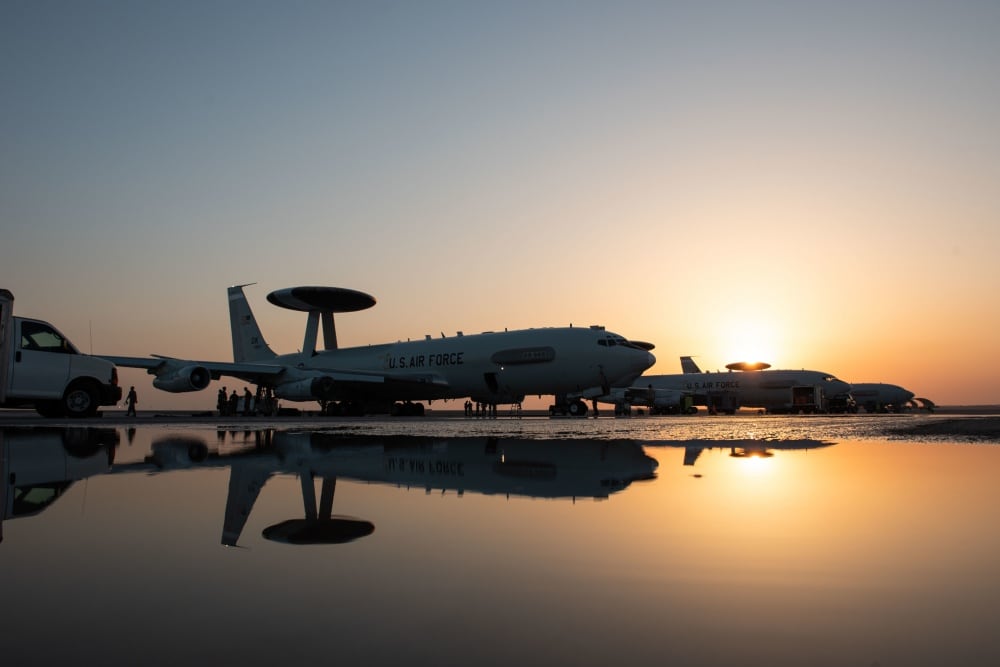Tinker Air Force Base in Oklahoma could soon bid farewell to its E-3 Sentry airborne target tracking jets that have been a fixture there for 45 years.
Under the Air Force’s fiscal 2023 budget request, released Monday, the Airborne Warning and Control System would phase out over the next few years to make way for Boeing’s E-7 Wedgetail as its likely replacement.
The E-3 AWACS is a modified 1970s-era airliner that uses a distinctive rotating radar dome to track air war movements up to 250 miles away and to direct planes in combat, such as telling fighter jets to intercept a hostile target. They have been active over Europe to monitor the region’s airspace during Russia’s ongoing invasion of neighboring Ukraine.
RELATED

Fifteen of Tinker’s planes would head into retirement in 2023, about half of the overall fleet at the 552nd Air Control Wing, the Air Force said. The United States owns 31 E-3s, split between 27 tails at Tinker and four that operate out of Joint Base Elmendorf-Richardson, Alaska, and Kadena Air Base in Japan.
NATO, the United Kingdom, France, Saudi Arabia and Japan operate the Sentry as well.
The remaining U.S. airframes will stay for “several years” until something better comes along, Maj. Gen. James Peccia, the Air Force’s deputy assistant budget secretary, told reporters March 25. Officials worry that the legacy fixed-wing command-and-control and intelligence, surveillance and reconnaissance platforms are too costly to maintain and would be vulnerable against modern and future surface-to-air missiles.
The Air Force acknowledges that ditching more than a dozen E-3s will leave a gap in its ability to monitor the skies, but argues it doesn’t pose an insurmountable problem.
The proposal follows years of debate over what may come next in airspace surveillance technology. The Wedgetail or another aircraft that succeeds the E-3 could bridge the gap between the former jet and the future Advanced Battle Management System (ABMS) concept, which would connect sensors across various Air Force platforms to form a picture of the battlespace around them.
Air Force Secretary Frank Kendall told reporters March 25 the service would make its decision on a replacement “within the next several months.”
RELATED

“The leading candidate, quite obviously, is the E-7, but we want to do our due diligence before we make a final decision,” he said.
Airmen at Tinker spoke to Air Force Times in July 2021 about low morale that has long plagued their AWACS units and is exacerbated by the stressors of an old, sometimes unpredictable aircraft. When asked what could be done to improve the culture there, multiple people said getting rid of the E-3 would be ideal.
The Sentries are frequently down for maintenance as they approach 50 years old, and airmen say the jets are prone to breaking in ways they haven’t seen before.
That issue was at the forefront of a disagreement between a now-fired operations group commander and his airmen over whether they should be required to train on short notice and atypical sleep.
“They are being presented with difficult risk management decisions regularly because of the older airframe,” said one officer in the community who requested anonymity because they were not authorized to speak to the press. “It is likely a lot less cut-and-dry on risk management than some communities, where they’re working with a platform that is more reliable for them.”
Rachel Cohen is the editor of Air Force Times. She joined the publication as its senior reporter in March 2021. Her work has appeared in the Washington Post, the Frederick News-Post (Md.), Air and Space Forces Magazine, Inside Defense, Inside Health Policy and elsewhere.




